Stem cell-homing hydrogel-based miR-29b-5p delivery promotes cartilage regeneration by suppressing senescence in an osteoarthritis rat model
- PMID: 35353555
- PMCID: PMC8967232
- DOI: 10.1126/sciadv.abk0011
Stem cell-homing hydrogel-based miR-29b-5p delivery promotes cartilage regeneration by suppressing senescence in an osteoarthritis rat model
Abstract
Osteoarthritis (OA) is a common joint disease characterized by progressive loss of cartilage and reduction in lubricating synovial fluid, which lacks effective treatments currently. Here, we propose a hydrogel-based miRNA delivery strategy to rejuvenate impaired cartilage by creating a regenerative microenvironment to mitigate chondrocyte senescence that mainly contributes to cartilage breakdown during OA development. An aging-related miRNA, miR-29b-5p, was first found to be markedly down-regulated in OA cartilage, and their up-regulation suppressed the expression of matrix metalloproteinases and senescence-associated genes (P16INK4a/P21) via ten-eleven-translocation enzyme 1 (TET1). An injectable bioactive self-assembling peptide nanofiber hydrogel was applied to deliver agomir-29b-5p, which was functionalized by conjugating a stem cell-homing peptide SKPPGTSS for endogenous synovial stem cell recruitment simultaneously. Sustained miR-29b-5p delivery and recruitment of synovial stem cells and their subsequent differentiation into chondrocytes led to successful cartilage repair and chondrocyte rejuvenation. This strategy enables miRNA-based therapeutic modality to become a viable alternative for surgery in OA treatment.
Figures
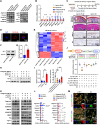
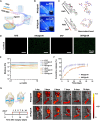

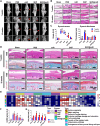
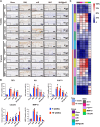
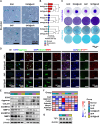
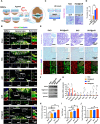
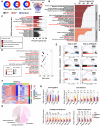
Comment in
-
Targeting senescence in OA.Nat Rev Rheumatol. 2022 Jun;18(6):305. doi: 10.1038/s41584-022-00788-2. Nat Rev Rheumatol. 2022. PMID: 35505106 No abstract available.
Similar articles
-
Intra-articular injection of hUC-MSCs expressing miR-140-5p induces cartilage self-repairing in the rat osteoarthritis.J Bone Miner Metab. 2020 May;38(3):277-288. doi: 10.1007/s00774-019-01055-3. Epub 2019 Nov 23. J Bone Miner Metab. 2020. PMID: 31760502
-
Attenuation of osteoarthritis progression via locoregional delivery of Klotho-expressing plasmid DNA and Tanshinon IIA through a stem cell-homing hydrogel.J Nanobiotechnology. 2024 Jun 10;22(1):325. doi: 10.1186/s12951-024-02608-z. J Nanobiotechnology. 2024. PMID: 38858695 Free PMC article.
-
Targeted lipid nanoparticles distributed in hydrogel treat osteoarthritis by modulating cholesterol metabolism and promoting endogenous cartilage regeneration.J Nanobiotechnology. 2024 Dec 20;22(1):786. doi: 10.1186/s12951-024-02965-9. J Nanobiotechnology. 2024. PMID: 39707367 Free PMC article.
-
Inflammation-Modulating Hydrogels for Osteoarthritis Cartilage Tissue Engineering.Cells. 2020 Feb 12;9(2):419. doi: 10.3390/cells9020419. Cells. 2020. PMID: 32059502 Free PMC article. Review.
-
Chondrocyte and mesenchymal stem cell-based therapies for cartilage repair in osteoarthritis and related orthopaedic conditions.Maturitas. 2014 Jul;78(3):188-98. doi: 10.1016/j.maturitas.2014.04.017. Epub 2014 May 2. Maturitas. 2014. PMID: 24855933 Review.
Cited by
-
BMSCs-targeting piezoelectric stimulation and immunomodulatory dual-functional hydrogel for promoting diabetic bone regeneration.Mater Today Bio. 2025 Jun 25;33:102015. doi: 10.1016/j.mtbio.2025.102015. eCollection 2025 Aug. Mater Today Bio. 2025. PMID: 40677405 Free PMC article.
-
Catalpol promotes articular cartilage repair by enhancing the recruitment of endogenous mesenchymal stem cells.J Cell Mol Med. 2024 Apr;28(7):e18242. doi: 10.1111/jcmm.18242. J Cell Mol Med. 2024. PMID: 38509736 Free PMC article.
-
Engineering approaches for RNA-based and cell-based osteoarthritis therapies.Nat Rev Rheumatol. 2024 Feb;20(2):81-100. doi: 10.1038/s41584-023-01067-4. Epub 2024 Jan 22. Nat Rev Rheumatol. 2024. PMID: 38253889 Free PMC article. Review.
-
Hexokinase 2 Suppression Alleviates the Catabolic Properties in Osteoarthritis via HMGA2 and Contributes to Pulsed Electromagnetic Field-mediated Cartilage Protection.Int J Biol Sci. 2025 Jan 27;21(4):1459-1477. doi: 10.7150/ijbs.101597. eCollection 2025. Int J Biol Sci. 2025. PMID: 39990654 Free PMC article.
-
New insights into the role of cellular senescence and rheumatic diseases.Front Immunol. 2025 May 16;16:1557402. doi: 10.3389/fimmu.2025.1557402. eCollection 2025. Front Immunol. 2025. PMID: 40453080 Free PMC article. Review.
References
-
- Hootman J. M., Helmick C. G., Projections of US prevalence of arthritis and associated activity limitations. Arthritis Rheum. 54, 226–229 (2006). - PubMed
-
- Hunter D. J., Bierma-Zeinstra S., Osteoarthritis. Lancet 393, 1745–1759 (2019). - PubMed
-
- Stanton H., Rogerson F. M., East C. J., Golub S. B., Lawlor K. E., Meeker C. T., Little C. B., Last K., Farmer P. J., Campbell I. K., Fourie A. M., Fosang A. J., ADAMTS5 is the major aggrecanase in mouse cartilage in vivo and in vitro. Nature 434, 648–652 (2005). - PubMed
MeSH terms
Substances
LinkOut - more resources
Full Text Sources
Other Literature Sources
Medical

